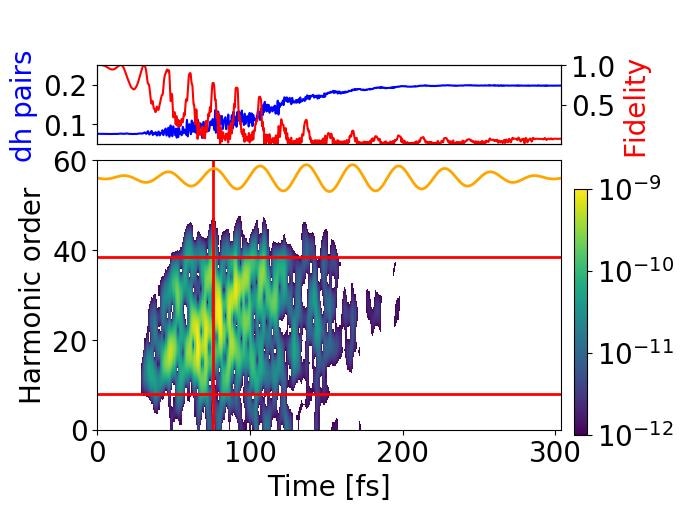Apr 18 2018
In the last few decades, the working speed of computers has increased more and more, and storage chips and hard disks have attained tremendous capacities. However, this course cannot persist forever: already, there have been physical limits that restrict silicon-based computer technology from achieving any remarkable speed gains from the current level.
Scientists are specifically confident that the next generation of technological developments will begin with the creation of innovative information-processing materials and technologies that integrate electrical circuits with optical circuits. A research group headed by Misha Ivanov of the Max Born Institute in Berlin along with researchers from the Russian Quantum Center in Moscow used short laser pulses to provide insights into the extremely rapid processes that occur inside these innovative materials. The outcomes of the study have been published in the prestigious Nature Photonics journal.
 High harmonic spectroscopy of light-induced phase transition. The vertical red line shows when the laser electric field (yellow oscillating curve) crosses the threshold field, destroying the insulating phase of the material. The top panel shows the average number of doublon-hole pairs per site (blue) and the decay of the insulating field-free ground state (red). (Image credit: MBI Berlin)
High harmonic spectroscopy of light-induced phase transition. The vertical red line shows when the laser electric field (yellow oscillating curve) crosses the threshold field, destroying the insulating phase of the material. The top panel shows the average number of doublon-hole pairs per site (blue) and the decay of the insulating field-free ground state (red). (Image credit: MBI Berlin)
“Strongly correlated systems,” named so due to the strong interactions occurring between the electrons in these materials, are of specific interest for modern material research in solid-state physics. A good example is magnets: in magnets, the electrons align themselves in a desired direction of spin within the material, which results in the production of the magnetic field. However, there are other, completely distinctive structural orders that need attention. For instance, in the case of so-called Mott insulators, a category of materials being extensively studied at present, the electrons must flow freely and hence the materials should be able to conduct electricity and also metals. However, their flow is hindered by the mutual interaction between electrons in such strongly correlated materials, and hence, the materials act as insulators instead.
The physical characteristics can be drastically changed by disrupting this order with the help of a strong laser pulse. This can be equated to a phase transition from solid to liquid: for instance, when ice melts, rigid ice crystals change into free-flowing water molecules. Quite analogously, when an external laser pulse compels a phase transition in the structural order of electrons in a strongly correlated material, they become free to flow. Phase transitions such as these can be used to develop completely new switching elements for next-era electronics that are more rapid and potentially more energy efficient than prevalent transistors. Theoretically, computers can be made nearly a thousand times faster by using light pulses to “turbo-charge” their electrical components.
The difficulty in analyzing these phase transitions is that they are exceptionally fast and it is hence very challenging to “catch them in the act.” To date, researchers have had to feel satisfied with the characterization of the state of a material before and after a phase transition of this type. However, scientists Rui E. F. Silva, Olga Smirnova, and Misha Ivanov from the Berlin Max Born Institute have now developed a technique that will truly provide insights into the process. Their concept involves irradiating a material with extremely short, customized laser pulses. These pulses of suitable quality could be generated only recently due to the latest advancements in lasers. Then, the material’s response to these pulses is observed to analyze the way the electrons in the material are excited into motion and, similar to a bell, emit resonant vibrations at particular frequencies, as harmonics of the incident light.
“By analyzing this high harmonic spectrum, we can observe the change in the structural order in these strongly correlated materials ‘live’ for the first time,” stated Rui Silva from the Max Born Institute, who is the first author of the study. Laser sources with the ability to target trigger such transitions have been developed only very recently. The laser pulses must be sufficiently strong and very short—of the order of femtoseconds in duration (millionths of a billionth of a second).
In certain cases, just a single oscillation of light is enough to disrupt the electronic order of a material and transform an insulator into a metal-like conductor. The researchers at the Berlin Max Born Institute are among the leading experts across the globe in the field of ultrashort laser pulses.
“If we want to use light to control the properties of electrons in a material, then we need to know exactly how the electrons will react to light pulses,” explained Ivanov. When used in combination with the new-generation laser sources, which enable complete control over the electromagnetic field even down to a single oscillation, this innovative published will provide in-depth insights into the futuristic materials.